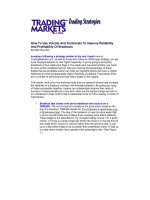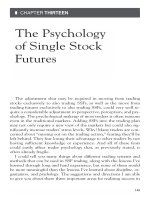How to use bar patterns to spot trade setups
Bạn đang xem bản rút gọn của tài liệu. Xem và tải ngay bản đầy đủ của tài liệu tại đây (430.61 KB, 5 trang )
How To Use Bar Patterns To Spot Trade Setups
A Club EWI exclusive report excerpted from the Trader’s Classroom Collection: Volume II.
/>1. “DOUBLE INSIDE BARS”
While many of my co-workers jog, bicycle or play in bands for a hobby, I amuse myself by looking through old price
charts of stocks and commodities. I try to limit the time I spend on my hobby to about a half-day on the weekends, but
often it encompasses the whole weekend, especially if it’s raining. Over the years I’ve made many observations and
notes, a few of which I like to share here in Trader’s Classroom. Let’s look at a bar pattern that I call a “double inside day.”
Many of you who subscribe to Daily Futures Junctures have
seen me mention this bar pattern. Although this price formation is nothing new or groundbreaking, it is so important that
I think everyone should be familiar with it. Why? Because it
often introduces sizable moves in price – always a good reason for a trader to pay attention.
So let’s begin with a basic definition: A double inside day, or
bar, occurs when two inside bars appear in a row. An inside
bar is simply a price bar with a high below the previous high
and a low above the previous low. Figure 11-1 illustrates what
a double inside bar pattern looks like. Notice that the range
of price bar number two encompasses price bar number one,
and price bar number three encompasses price bar number
two.
Figure 11-2
Figure 11-3
The Trader’s Classroom Collection: Volume 2 — published by Elliott Wave International — www.elliottwave.com
1
How To Use Bar Patterns To Spot Trade Setups
Figure 11-4
Figure 11-5
Figures 11-2 through 11-5 (Wheat, Orange Juice, Feeder
Cattle and Soybean Oil) show examples of double inside days
and the price moves that followed. In each instance, I believe
these formations introduced tradable moves.
2. “ARROWS”
Now that we are all on the same side of the fence, let me
introduce you to another price pattern that I call the “arrow.”
An arrow is simply a modified double inside day formation.
Instead of using three price bars, it requires four. In Figure
11-6, you can see that price bar number one is an inside bar
and that price bar number two is an inside bar in relation to
bars three and four.
Figure 11-6
Figure 11-7
Figure 11-8
The Trader’s Classroom Collection: Volume 2 — published by Elliott Wave International — www.elliottwave.com
2
How To Use Bar Patterns To Spot Trade Setups
Figure 11-9
Figure 11-10
• The high of bar two is below the high of bar three.
• The low of bar two is above the low of bar four.
Now let’s look at some examples. In Figures 11-7 through 11-9 (Cotton, Coffee and Soybeans), it’s easy to see that each
arrow introduced a tradable move much like our double inside day formation did. One way to think of an arrow is that it
is simply a hidden double inside day, or bar. I’ve saved the best for last. On the left hand side of Figure 11-10 (Crude Oil),
you can see a double inside bar that introduced a selloff in just a few short hours from 57.08 to 53.40. On the right hand
side of the chart, you can see an arrow formation that included the (then) all-time high in Crude Oil at 58.20 and led to
about an $8 drop in prices soon after. That’s what I mean by a sizable move in price.
3. “POPGUNS”
I’m no doubt dating myself, but
when I was a kid, I had a popgun
– the old-fashioned kind with a
cork and string (no fake Star
Wars light saber for me). You
pulled the trigger, and the cork
popped out of the barrel attached
to a string. If you were like me,
you immediately attached a
longer string to improve the
popgun’s reach. Why the reminiscing? Because “Popgun” is
the name of a bar pattern I would
like to share with you this
month. And it’s the path of the
cork (out and back) that made
me think of the name for this
pattern.
Figure 11-11
Figure 11-12
The Trader’s Classroom Collection: Volume 2 — published by Elliott Wave International — www.elliottwave.com
3
How To Use Bar Patterns To Spot Trade Setups
The Popgun is a two-bar pattern composed of an outside bar preceded by an
inside bar, as you can see in Figure 1111. (Quick refresher course: An outside
bar occurs when the range of a bar encompasses the previous bar and an inside
bar is a price bar whose range is encompassed by the previous bar.) In Figure 1112 (Coffee), I have circled two Popguns.
So what’s so special about the Popgun? It
introduces swift, tradable moves in price.
More importantly, once the moves end,
they are significantly retraced, just like the
popgun cork going out and back. As you
can see in Figure 11-13 (Coffee), prices
advance sharply following the Popgun,
and then the move was significantly retraced. In Figure 11-14 (Coffee), we see
the same thing again but to the downside:
prices fall dramatically after the Popgun,
and then a sizable correction develops.
How can we incorporate this bar pattern
into our Elliott wave analysis? The best
way is to understand where Popguns show
up in the wave patterns. I have noticed that
Popguns tend to occur prior to impulse
waves – waves one, three and five. But,
remember, waves A and C of corrective
wave patterns are also technically impulse
waves. So Popguns can occur prior to
those moves as well.
Figure 11-13
Figure 11-14
The Trader’s Classroom Collection: Volume 2 — published by Elliott Wave International — www.elliottwave.com
4
How To Use Bar Patterns To Spot Trade Setups
As with all my work, I rely on a pattern only if it applies across all time frames and markets. To illustrate, I have included
two charts of Sirius Satellite Radio (SIRI) that show this pattern works equally well on 60-minute and weekly charts.
Notice that the Popgun on the 60-minute chart (Figure 11-15) preceded a small third wave advance. Now look at the
weekly chart (Figure 11-16) to see what three Popguns introduced (from left to right): wave C of a flat correction, wave
5 of (3) and wave C of (4).
Figure 11-15
Figure 11-16
There’s only one more thing to know about using this Popgun trade setup: Just be careful and don’t shoot your eye out, as
my mom would say.
ADDITIONAL TRADING RESOURCES
Free Video Lesson: How to Trade Diagonal Triangles
Watch a free video lesson from Jeffrey Kennedy’s latest trading course, Diagonal Triangles: Superior Risk/Reward Trade
Setups. Visit:
/>
Get the Trader’s Classroom Collection Ebooks, Free
Get more of Jeffrey Kennedy’s trading lessons in Trader’s Classroom Collection: Volumes I & II. The ebooks are packed
with 23 chapters of valuable trading lessons that teach you how to identify turns and trends in the market. Available for
purchase or free with a risk-free subscription to Futures Junctures Service. Visit:
/>
Free Club EWI Report: Learn How Fibonacci Techniques Can Identify Market Turns
Read another great Trader’s Classroom lesson from Jeffrey Kennedy, previously featured in Club EWI. Visit:
/>
The Trader’s Classroom Collection: Volume 2 — published by Elliott Wave International — www.elliottwave.com
5









